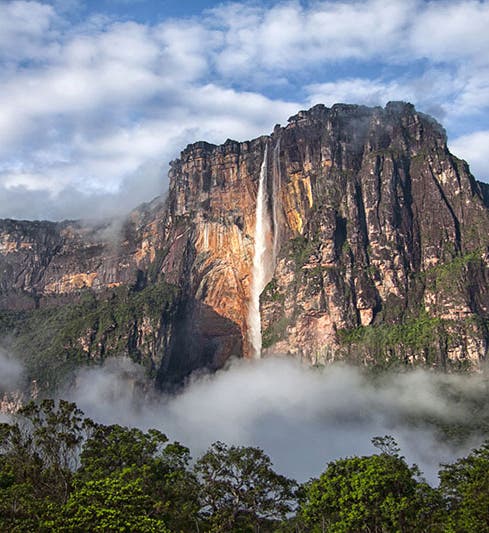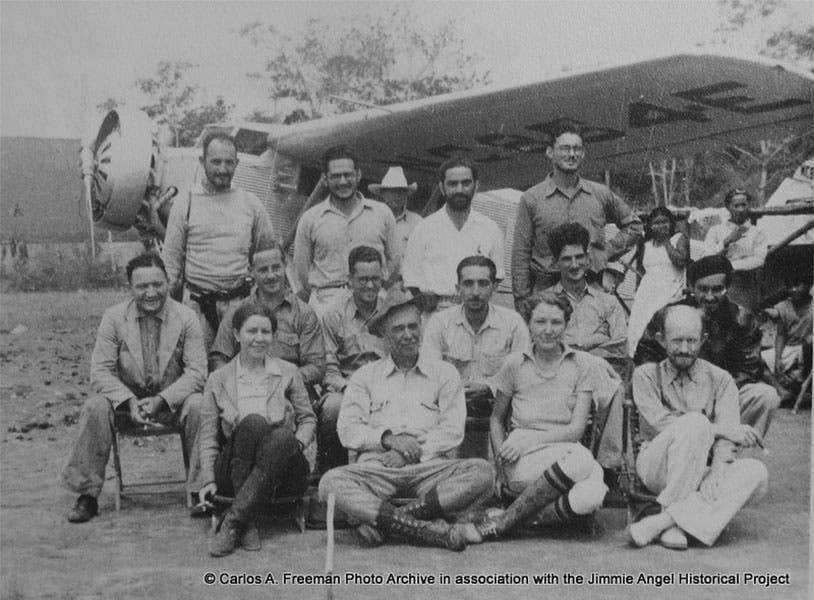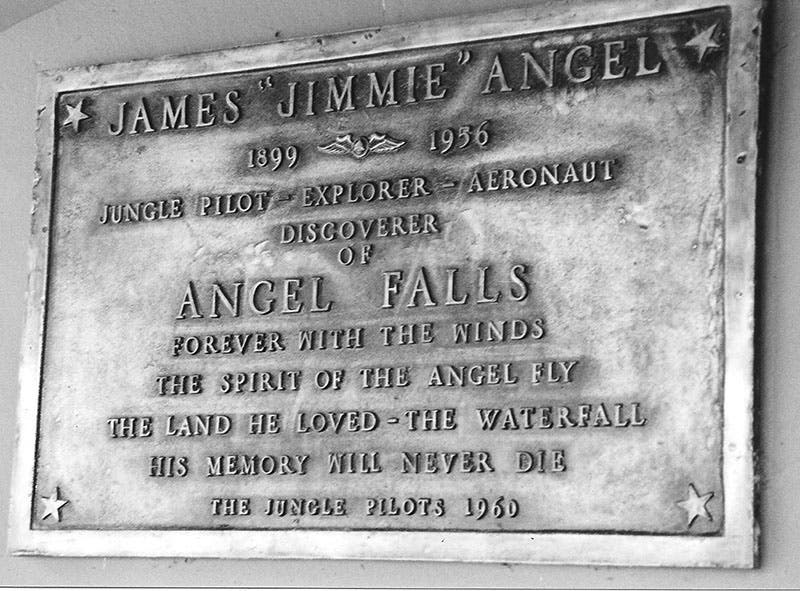Scientist of the Day - Jimmie Angel
Jimmie Angel, an American aviator and explorer, died Dec. 8, 1956, at the age of 57. Angel earned his pilot's license when he was quite young, and for a while he made his living as part of a barnstorming flying circus. He first went to Venezuela in 1921, although it wasn't until 1933 that he returned full-time as a pilot for various mining companies that were surveying the area of southeastern Venezuela, near the border of Guyana. The country there is dotted with tepuis – mesas that can be three to five thousand feet tall and are almost unreachable from the valley floor. This blog post shows spectacular aerial views of some of the more striking tepuis in the Venezuelan highlands.
It was while on a solo flight on Nov. 18, 1933, that Angel flew over one of the tepuis, Auyán-tepui, and saw the granddaddy of all waterfalls, freefalling for what he guessed was a mile (3000 ft. would have been a more accurate estimate). He wrote up the discovery in his log, and told lots of people about it, but he was not believed, perhaps because he already had a reputation for bending the truth when recounting his exploits. A few years later he reeled in his first witnesses, when two explorers he was ferrying about were treated to the sight of what Jimmie called "my waterfall". One of them recorded in his diary: "My eyes must have been popping right out of my head. I could only stare in amazement. It looked like an immense rope hanging over the canyon wall, and it fell for all of 3000 feet, possibly more, without interruption, until it spread out into a billowy cloud of fine, fluffy mist." When we look at a photo of the Falls, we are impressed, but hardly stupefied. No doubt these witnesses owed much of their awe to the fact that Jimmy flew so close to the falls that it splattered the wings of the aircraft with water.
Four years after his discovery, Jimmie Angel pulled off another memorable feat, when on Oct. 9, 1937, he landed a party of explorers on top of Auyán-tepui, the first ever such landing. Perhaps one should say, "almost pulled off," because at the end of the landing run, the wheels ran into some soft mud and the plane pitched up on its nose, never to fly again. It took the party 11 days to hike down and out. The map of Auyán-tepui (third image, just above) shows the spot of the abortive landing (lugar avioneta Jimmie Angel), and the path taken to get down off the tepui. You can also see that Angel Falls (Salto Angel) is located on the side of an internal canyon, which is why it was not observed by previous explorers in the valley. The plane sat there for 33 years (Jimmie and the crew had lowered its tail before they left, since Jimmie thought its nose-in-the-mud resting position was "undignified"), and then in 1970 it was taken apart, ferried down by helicopter, and reassembled in front of the Ciudad Bolivar airport, where it sits today.
In 1939, Angel flew in the members of the Great Savannah Expedition, which was to explore all of Venezuelan Guyana, and one of the members for a short period was George Gaylord Simpson, on his way to becoming one of the great American evolutionary biologists. In March of 1939, Angel took Simpson and his wife Anne (as well as Angel's own wife Marie) to see the falls. Simpson, who was a fairly level-headed zoologist and ethnographer, rhapsodized for a full paragraph in his diary: "I have been practically speechless ever since and even now I just have a sort of sinking hopeless feeling at trying to record even a bare hint of what all this is like. It is grand, awesome, awful, beautiful, marvelous, and terrible. It seems impossible that such things can exist on our earth. It makes the greatest famous scenery of the world seem puny...” Clearly this is a wonder of the world that one has to see in person, and close-up. There is a photograph of the members of the Great Savannah Expedition of 1939 (second image) Angel is on the chair at far left, with his wife Marie, while Simpson and his wife Anne are in the front row at far right.
The falls were officially named Angel Falls on a map issued by the Venezuelan government in 1939. In 2009, the president of Venezuela unilaterally declared that he was changing the name of Angel Falls to its aboriginal Pemón name, Kerepacupai Meru, but so far he has been universally ignored, even in his own country (it did not help that Kerepacupai is the indigenous name for a section of Auyán-tepui that is far from Angel Falls – there is no Pemón name for Angel Falls). Jimmie Angel is apparently regarded as a native Venezuelan and a favorite son of the country, and thus Angel Falls seems to serve quite well as an indigenous name.
There is a plaque honoring Angel in Canaima National Park, the World Heritage Site in southeastern Venezuela that includes most of the tepuis, and Angel Falls (fifth image, just above). Angel died on on this date in 1958 of a cerebral hemorrhage. His ashes were scattered over Angel Falls in 1960 by his wife and family.
I would like to acknowledge with gratitude the Jimmie Angel Historical Project, which maintains an excellent website at jimmieangel.org. Normally I do not like to use more than one image from any one website, but in this case, I used three, because I could not find equivalent images anywhere else. The information provided on the website is also valuable and often unavailable elsewhere.
Dr. William B. Ashworth, Jr., Consultant for the History of Science, Linda Hall Library and Associate Professor emeritus, Department of History, University of Missouri-Kansas City. Comments or corrections are welcome; please direct to ashworthw@umkc.edu.










